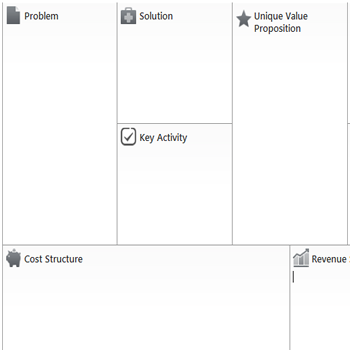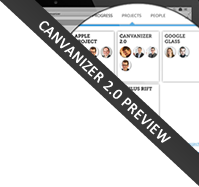Lean Canvas is an adaptation of Business Model Canvas by Alexander Osterwalder which Ash Maurya created in the Lean Startup spirit (Fast, Concise and Effective startup).
Lean Canvas promises an actionable and entrepreneur-focused business plan. It focuses on problems, solutions, key metrics and competitive advantages. The structure is similar to the well-known Business Model Canvas, but some sections have been exchanged.For more information about the author of this canvas, please refer to the blogpost explaining Lean Canvas and the ideas behind it on his website: http://www.ashmaurya.com/2012/02/why-lean-canvas/
If you want to try it out without entering your email address, please use our public Lean Demo Canvas for a first impression.

More about the Lean Canvas
Lean Canvas: Summary
Alex Osterwalder’s Business Model Generation is a great hit that illustrates a range of planning and marketing strategies for competitive and business success. However, more ideas have come up from this model, among which is the Lean Canvas by Ash Maurya. While the Business Model Generation applied the methodologies used by Skype and Apple to attain product success in the market, the Lean Canvas concentrated on the way timeline affects the revenue stream of a business. It is therefore more target-specific and incorporates both small and large businesses effectively. It is a perfect model which took a few months to rewrite.
The Lean Canvas is more actionable and entrepreneur-focused. It deeply focuses on startup factors such as uncertainty and risk. Because it was space constrained, Ash Maurya added more elements:
- Problem- a problem box was included because several businesses do fail applying a lot of effort, financial resources and time to build the wrong product. It is therefore vital to understand the problem first. What is the problem users have that your business will address? Formulating it will help you to make sure that you are meeting an existing need.
- Solution- once a problem has been recognized the next thing is to find an amicable solution to it. As such, a solution box with the Minimum Viable Product “MVP” concept was included. How will your business help the users solve their problem? It is a purposefully small box — the solution needs to be concisely written and specific.
- Key Metrics- a startup business can better focus on one metric and build on it. The metrics include the range of products or services you want to provide. It is therefore crucial that the right metric is identified because the wrong one could be catastrophic to the startup. Here put things you can measure that will reflect the state of your business or the strength of your proposal (e.g. at least X% subscriptions, X downloads in the first week, the process sped up by X%). The metrics will be your research objects and then the evidence of efficiency you will show to your stakeholders.
- Unfair Advantage- this is basically the competitive advantage. A startup should recognize whether or not it has an unfair advantage over others.
- Unique Value Proposition Here write down a marketable promise to the target user that you will solve their problem. Formulate it in a way that will capture their imagination (e.g. “Brainstorm better concepts. Together with your team.” would be the unique value proposition for Canvanizer).
- Cost structure In this field write down things you will have to pay for to bring the product to the client (e.g. salaries, cost of the materials, cost of maintenance).
- Revenue streamsx How will your product will bring money (e.g. sales, subscription)?
There are a few other things that Ash Maurya omitted from the original Lean Canvas in an attempt to improve it. These include:
- Key Activities and Key Resources- Ash found out that they were more outside-focused when gauged with the entrepreneur’s needs. They had also been covered in the Solution box.
- Customer Relationships- a deeply focused startup business should establish customer relationships from the beginning. As such, these were covered in the Channels box.
- Key Partners- Ash removed this category regarding the fact that most startups don’t require specific key partners when putting up because they deal in unknown and untested products. As such, it would be a waste of time trying to build such relationships.
The Lean Canvas is also majorly meant for entrepreneurs and not the customers, consultants, investors or advisors. It has no specific medium of implementation and you can use it first and then shift to the Business Model Canvas or either way.

